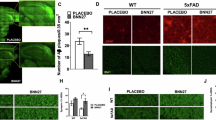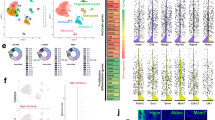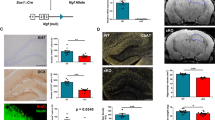Abstract
ProNGF, the precursor of mature nerve growth factor (NGF), is the most abundant form of NGF in the brain. ProNGF and mature NGF differ significantly in their receptor interaction properties and in their bioactivity. ProNGF increases markedly in the cortex of Alzheimer’s disease (AD) brains and proNGF\NGF imbalance has been postulated to play a role in neurodegeneration. However, a direct proof for a causal link between increased proNGF and AD neurodegeneration is lacking. In order to evaluate the consequences of increased levels of proNGF in the postnatal brain, transgenic mice expressing a furin cleavage-resistant form of proNGF, under the control of the neuron-specific mouse Thy1.2 promoter, were derived and characterized. Different transgenic lines displayed a phenotypic gradient of neurodegenerative severity features. We focused the analysis on the two lines TgproNGF#3 and TgproNGF#72, which shared learning and memory impairments in behavioral tests, cholinergic deficit and increased Aβ-peptide immunoreactivity. In addition, TgproNGF#3 mice developed Aβ oligomer immunoreactivity, as well as late diffuse astrocytosis. Both TgproNGF lines also display electrophysiological alterations related to spontaneous epileptic-like events. The results provide direct evidence that alterations in the proNGF/NGF balance in the adult brain can be an upstream driver of neurodegeneration, contributing to a circular loop linking alterations of proNGF/NGF equilibrium to excitatory/inhibitory synaptic imbalance and amyloid precursor protein (APP) dysmetabolism.
Similar content being viewed by others
Log in or create a free account to read this content
Gain free access to this article, as well as selected content from this journal and more on nature.com
or
Abbreviations
- NGF:
-
nerve growth factor
- AD:
-
Alzheimer’s disease
- Aβ:
-
amyloid-β
- APP:
-
amyloid precursor protein
- IRES:
-
internal ribosome entry site sequence
- EGFP:
-
green fluorescent protein
- CTX:
-
cortex
- WT:
-
wild type
- AA:
-
active avoidance test
- ORT:
-
object recognition test
- MWM:
-
Morris water maze test
- ChAT:
-
choline acetyltransferase
- BFCN:
-
basal forebrain cholinergic neurons
- HP:
-
hippocampus
- BF:
-
basal forebrain
- GFAP:
-
glial fibrillar acidic protein
- ScFv:
-
single-chain antibody fragment
- AβO:
-
Aβ oligomers
- EC:
-
entorhinal cortex
- LTP:
-
long-term potentiation
- IP:
-
immunoprecipitation
- Tg:
-
transgenic
- DS:
-
Down syndrome
- E\I:
-
excitatory\inhibitory
- MCI:
-
mild cognitive impairment
- MMP:
-
matrix metalloproteinase
- DG:
-
dentate gyrus
References
Francke U, de Martinville B, Coussens L, Ullrich A . The human gene for the beta subunit of nerve growth factor is located on the proximal short arm of chromosome. Science 1983; 222: 1248–1251.
Scott J, Selby M, Urdea M, Quiroga M, Bell GI, Rutter WJ . Isolation and nucleotide sequence of a cDNA encoding the precursor of mouse nerve growth factor. Nature 1983; 302: 538–540.
Fahnestock M, Michalski B, Xu B, Coughlin MD . The precursor pro-nerve growth factor is the predominant form of nerve growth factor in brain and is increased in Alzheimer’s disease. Mol Cell Neurosci 2001; 18: 210–220.
Lee R, Kermani P, Teng KK, Hempstead BL . Regulation of cell survival by secreted proneurotrophins. Science 2001; 294: 1945–1948.
Seidah NG, Benjannet S, Pareek S, Savaria D, Hamelin J, Goulet B et al. Cellular processing of the nerve growth factor precursor by the mammalian pro-protein convertases. Biochem J 1996; 314 (Pt 3): 951–960.
Bruno MA, Cuello AC . Activity-dependent release of precursor nerve growth factor, conversion to mature nerve growth factor, and its degradation by a protease cascade. Proc Natl Acad Sci USA 2006; 103: 6735–6740.
Bruno MA, Leon WC, Fragoso G, Mushynski WE, Almazan G, Cuello AC . Amyloid beta-induced nerve growth factor dysmetabolism in Alzheimer disease. J Neuropathol Exp Neurol 2009; 68: 857–869.
Beattie MS, Harrington AW, Lee R, Kim JY, Boyce SL, Longo FM et al. ProNGF induces p75-mediated death of oligodendrocytes following spinal cord injury. Neuron 2002; 36: 375–386.
Harrington AW, Leiner B, Blechschmitt C, Arevalo JC, Lee R, Mörl K et al. Secreted proNGF is a pathophysiological death-inducing ligand after adult CNS injury. Proc Natl Acad Sci USA 2004; 101: 6226–6230.
Nykjaer A, Lee R, Teng KK, Jansen P, Madsen P, Nielsen MS et al. Sortilin is essential for proNGF-induced neuronal cell death. Nature 2004; 427: 843–848.
D’Onofrio M, Paoletti F, Arisi I, Brandi R, Malerba F, Fasulo L et al. NGF and proNGF regulate functionally distinct mRNAs in PC12 cells: an early gene expression profiling. PLoS One 2011; 6: e20839.
Rattenholl A, Lilie H, Grossmann A, Stern A, Schwarz E, Rudolph R . The pro-sequence facilitates folding of human nerve growth factor from Escherichia coli inclusion bodies. Eur J Biochem 2001; 268: 3296–3303.
Kaplan DR, Martin-Zanca D, Parada LF . Tyrosine phosphorylation and tyrosine kinase activity of the trk proto-oncogene product induced by NGF. Nature 1991; 350: 158–160.
Klein R, Jing SQ, Nanduri V, O'Rourke E, Barbacid M . The trk proto-oncogene encodes a receptor for nerve growth factor. Cell 1991; 65: 189–197.
Puglielli L . Aging of the brain, neurotrophin signaling, and Alzheimer’s disease: is IGF1-R the common culprit? Neurobiol Aging 2008; 29: 795–811.
Masoudi R, Ioannou MS, Coughlin MD, Pagadala P, Neet KE, Clewes O et al. Biological activity of nerve growth factor precursor is dependent upon relative levels of its receptors. J Biol Chem 2009; 284: 18424–18433.
Capsoni S, Cattaneo A . On the molecular basis linking nerve growth factor (NGF) to Alzheimer’s disease. Cell Mol Neurobiol 2006; 26: 619–633.
Capsoni S, Tiveron C, Vignone D, Amato G, Cattaneo A . Dissecting the involvement of tropomyosin-related kinase A and p75 neurotrophin receptor signaling in NGF deficit-induced neurodegeneration. Proc Natl Acad Sci USA 2010; 107: 12299–12304.
Peng S, Wuu J, Mufson EJ, Fahnestock M . Increased proNGF levels in subjects with mild cognitive impairment and mild Alzheimer disease. J Neuropathol Exp Neurol 2004; 63: 641–649.
Ginsberg SD, Che S, Wuu J, Counts SE, Mufson EJ . Down regulation of trk but not p75NTR gene expression in single cholinergic basal forebrain neurons mark the progression of Alzheimer’s disease. J Neurochem 2006; 97: 475–487.
Counts SE, Mufson EJ . The role of nerve growth factor receptors in cholinergic basal forebrain degeneration in prodromal alzheimer disease. J Neuropathol Exp Neurol 2005; 64: 263–272.
Caroni P . Overexpression of growth-associated proteins in the neurons of adult transgenic mice. J. Neurosci Methods 1997; 71: 3–9.
Feng G, Mellor RH, Bernstein M, Keller-Peck C, Nguyen QT, Wallace M et al. Imaging neuronal subsets in transgenic mice expressing multiple spectral variants of GFP. Neuron 2000; 28: 41–51.
Li Z, Burrone J, Tyler WJ, Hartman KN, Albeanu DF, Murthy VN . Synaptic vesicle recycling studied in transgenic mice expressing synaptopHluorin. Proc Natl Acad Sci USA 2005; 102: 6131–6136.
Haass C, Selkoe DJ . Soluble protein oligomers in neurodegeneration: lessons from the Alzheimer’s amyloid beta-peptide. Nat Rev Mol Cell Biol 2007; 8: 101–112.
Meli G, Visintin M, Cannistraci I, Cattaneo A . Direct in vivo intracellular selection of conformation-sensitive antibody domains targeting Alzheimer’s amyloid-beta oligomers. J Mol Biol 2009; 387: 584–606.
Holcomb L, Gordon MN, McGowan E, Yu X, Benkovic S, Jantzen P et al. Accelerated Alzheimer-type phenotype in transgenic mice carrying both mutant amyloid precursor protein and presenilin 1 transgenes. Nat Med 1998; 4: 97–100.
Capsoni S, Ugolini G, Comparini A, Ruberti F, Berardi N, Cattaneo A . Alzheimer-like neurodegeneration in aged antinerve growth factor transgenic mice. Proc Natl Acad Sci USA 2000; 97: 6826–6831.
Palop JJ, Chin J, Roberson ED, Wang J, Thwin MT, Bien-Ly N et al. Aberrant excitatory neuronal activity and compensatory remodeling of inhibitory hippocampal circuits in mouse models of Alzheimer’s disease. Neuron 2007; 55: 697–711.
Palop JJ, Mucke L . Epilepsy and cognitive impairments in Alzheimer disease. Arch Neurol 2009; 66: 435–440.
Lagostena L, Rosato-Siri M, D'Onofrio M, Brandi R, Arisi I, Capsoni S et al. In the adult hippocampus, chronic nerve growth factor deprivation shifts GABAergic signaling from the hyperpolarizing to the depolarizing direction. J Neurosci 2010; 30: 885–893.
Rosato-Siri M, Cattaneo A, Cherubini E . Nicotine-induced enhancement of synaptic plasticity at CA3-CA1 synapses requires GABAergic interneurons in adult anti-NGF mice. J Physiol 2006; 576 (Pt 2): 361–377.
Berretta N, Ledonne A, Mango D, Bernardi G, Mercuri NB . Hippocampus vs. entorhinal cortex decoupling by an NR2 subunit-specific block of NMDA receptors in a rat in vitro model of temporal lobe epilepsy. Epilepsia 2012; 53: e80–e84.
Avoli M, D'Antuono M, Louvel J, Köhling R, Biagini G, Pumain R et al. Network and pharmacological mechanisms leading to epileptiform synchronization in the limbic system in vitro. Prog Neurobiol 2002; 68: 167–207.
Cattaneo A, Rapposelli B, Calissano P . Three distinct types of monoclonal antibodies after long-term immunization of rats with mouse nerve growth factor. J Neurochem 1988; 50: 1003–1010.
Reinshagen M, Geerling I, Eysselein VE, Adler G, Huff KR, Moore GP et al. Commercial recombinant human beta-nerve growth factor and adult rat dorsal root ganglia contain an identical molecular species of nerve growth factor prohormone. J Neurochem 2000; 74: 2127–2133.
Salehi Z, Mashayekhi F . Nerve growth factor level in the cerebrospinal fluid in hydrocephalus. Cerebrospinal Fluid Research 2004; 1 (Suppl 1): S34.
Fortress AM, Buhusi M, Helke KL, Granholm AC, Cholinergic AC . Degeneration and alterations in the TrkA and p75NTR balance as a result of pro-NGF injection into aged rats. J Aging Res 2011; 2011: 460543.
Kichev A, Ilieva EV, Piñol-Ripoll G, Podlesniy P, Ferrer I, Portero-Otín M et al. Cell death and learning impairment in mice caused by in vitro modified pro-NGF can be related to its increased oxidative modifications in Alzheimer disease. Am J Pathol 2009; 175: 2574–2585.
Shankar GM, Walsh DM . Alzheimer’s disease: synaptic dysfunction and A-beta. Mol Neurodegener 2009; 23: 48.
Harris JA, Devidze N, Verret L, Ho K, Halabisky B, Thwin MT et al. Transsynaptic progression of amyloid-β-induced neuronal dysfunction within the entorhinal-hippocampal network. Neuron 2010; 68: 428–441.
Verkhratsky A, Olabarria M, Noristani HN, Yeh CY, Rodriguez JJ . Astrocytes in Alzheimer’s disease. Neurotherapeutics 2010; 7: 399–412.
Li C, Zhao R, Gao K, Wei Z, Yin MY, Lau LT et al. Astrocytes: implications for neuroinflammatory pathogenesis of Alzheimer’s disease. Curr Alzheimer Res 2011; 1 8: 67–80.
Domeniconi M, Hempstead BL, Chao MV . Pro-NGF secreted by astrocytes promotes motor neuron cell death. Mol Cell Neurosci 2007; 34: 271–279.
Menéndez M . Down syndrome, Alzheimer’s disease and seizures. Brain Dev 2005; 27: 246–252.
Abou-Khalil BW . How important is Alzheimer’s disease as a risk factor for unprovoked seizures and epilepsy in the elderly? Epilepsy Curr 2010; 10: 36–37.
De Simone R, Puig XS, Gélisse P, Crespel A, Genton P . Senile myoclonic epilepsy: delineation of a common condition associated with Alzheimer’s disease in Down syndrome. Seizure 2010; 19: 383–389.
Rissman RA, Mobley WC . Implications for treatment: GABAA receptors in aging, Down syndrome and Alzheimer’s disease. J Neurochem 2011; 117: 613–622.
Volosin M, Song W, Almeida RD, Kaplan DR, Hempstead BL, Friedman WJ . Interaction of survival and death signaling in basal forebrain neurons: roles of neurotrophins and proneurotrophins. J Neurosci 2006; 26: 7756–7766.
Perez SE, He B, Muhammad N, Oh KJ, Fahnestock M, Ikonomovic MD et al. Cholinotrophic basal forebrain system alterations in 3xTg-AD transgenic mice. Neurobiol Dis 2011; 41: 338–352.
Mufson EJ, He B, Nadeem M, Perez SE, Counts SE, Leurgans S et al. Hippocampal ProNGF signaling pathways and β-amyloid levels in mild cognitive impairment and Alzheimer disease. J Neuropathol Exp Neurol 2012; 71: 1018–1029.
Müller M, Triaca V, Besusso D, Costanzi M, Horn JM, Koudelka J et al. Loss of NGF-TrkA signaling from the CNS is not sufficient to induce cognitive impairments in young adult or intermediate-aged mice. J Neurosci 2012; 32: 14885–14898.
Kalous A, Nangle MR, Anastasia A, Hempstead BL, Keast JR . Neurotrophic actions initiated by proNGF in adult sensory neurons may require peri-somatic glia to drive local cleavage to NGF. J Neurochem 2012; 122: 523–536.
Chakravarthy B, Ménard M, Ito S, Gaudet C, Dal Prà I, Armato U et al. Hippocampal membrane-associated p75NTR levels are increased in Alzheimer's disease. J Alzheimer Dis 2012; 30: 675–684.
Cattaneo A, Capsoni S, Paoletti F . Towards non invasive nerve growth factor therapies for Alzheimer’s disease. J Alzheimers Dis 2008; 15: 255–283.
Paoletti F, Covaceuszach S, Konarev PV, Gonfloni S, Malerba F, Schwarz E et al. Intrinsic structural disorder of mouse proNGF. Proteins 2009; 75: 990–1009.
Vidal M, Morris R, Grosveld F, Spanopoulou E . Tissue specific control elements of the thy-1 gene. EMBO J 1990; 9: 833–840.
Ciana P, Braliou GG, Demay FG, Von Lindern M, Barettino D, Beug H et al. Leukemic transformation by the v-ErbA oncoprotein entails constitutive binding to and repression of an erythroid enhancer in vivo. EMBO J 1998; 17: 7382–7394.
Pavone F, Battaglia M, Sansone M . Prevention of amitriptyline-induced avoidance impairment by tacrine in mice. Behav Brain Res 1997; 89: 229–236.
Middei S, Roberto A, Berretta N, Panico MB, Lista S, Bernardi G et al. Learning discloses abnormal structural and functional plasticity at hippocampal synapses in the APP23 mouse model of Alzheimer's disease). Learn Mem 2010; 17: 236–240.
Acknowledgements
This paper is dedicated to our beloved friend and coauthor Cecilia Tiveron, who made a crucial contribution to this project before she passed away on 17 December 2010, as a tribute to her enthusiasm and dedication to science and to her friendship. We also dedicate the paper to Professor Rita Levi-Montalcini, Nobel Laureate founder of the EBRI institute, tireless and enthusiastic example for all of us. This work was funded by EU FP6 MEMORIES Project (no. 037831), Telethon grant no. GGP05234, the Italian Institute of Technology (IIT), the Italian Ministry of Higher Education and Scientific Research (FIRB no. RBAP10L8TY) and Fondazione Roma. We thank Domenico Vignone for valuable help with the immunohistochemistry experiments and Andrea Urbani for advise on the mass spectrometry analysis.
Author information
Authors and Affiliations
Corresponding author
Ethics declarations
Competing interests
The authors declare no conflict of interest.
Additional information
Edited by L Greene
Supplementary Information accompanies this paper on Cell Death and Differentiation website
Supplementary information
Rights and permissions
About this article
Cite this article
Tiveron, C., Fasulo, L., Capsoni, S. et al. ProNGF\NGF imbalance triggers learning and memory deficits, neurodegeneration and spontaneous epileptic-like discharges in transgenic mice. Cell Death Differ 20, 1017–1030 (2013). https://doi.org/10.1038/cdd.2013.22
Received:
Revised:
Accepted:
Published:
Issue date:
DOI: https://doi.org/10.1038/cdd.2013.22
Keywords
This article is cited by
-
Prenylated Flavanone Isolated from Dalea Species as a Potential Multitarget-Neuroprotector in an In Vitro Alzheimer’s Disease Mice Model
Neurotoxicity Research (2024)
-
Surfeit Locus Protein 4 as a Novel Target for Therapeutic Intervention in Cerebral Ischemia–Reperfusion Injury
Molecular Neurobiology (2023)
-
Transcriptomic Analyses of Neurotoxic Astrocytes Derived from Adult Triple Transgenic Alzheimer’s Disease Mice
Journal of Molecular Neuroscience (2023)
-
Finding memo: versatile interactions of the VPS10p-Domain receptors in Alzheimer’s disease
Molecular Neurodegeneration (2022)
-
The emerging role of furin in neurodegenerative and neuropsychiatric diseases
Translational Neurodegeneration (2022)



